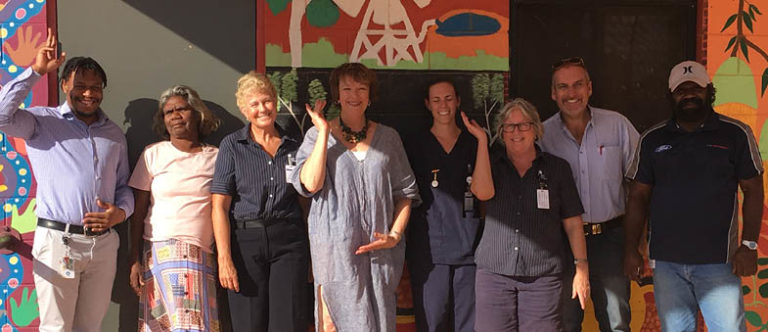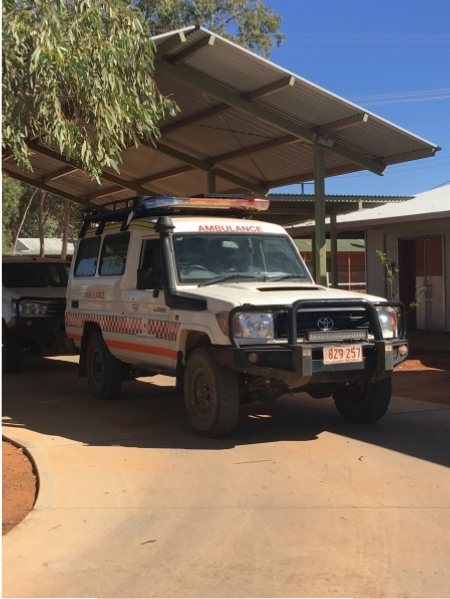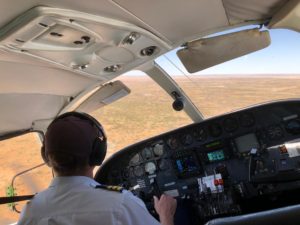Surveyors in Focus
A ‘Pair of Surveyors’ accreditation adventure

AGPAL Surveyors with Alpurrurulam Community Health Centre Staff
AGPAL Surveyors, Dr Susan Furphy and Mrs Jannine De Veau, undertook an ‘accreditation adventure’ across the Northern Territory (NT) to carry out on-site assessments at three remote health service clinics located within the Titjikala, Yuendumu and Alpurrurulam communities. The clinics are part of the Central Australia Health Service (CAHS) which covers 64.7 percent, or 872,861 square kilometres, of the NT.
The assessments occurred during a three-day period, with one day either side for travel to and from Alice Springs—with Susan traveling from her hometown of Shepparton in Victoria, and Jannine from Sydney.
Following the first day’s assessment at Titjikala accessed via road, CAHS provided a charter flight for the second and third days to reach Yuendumu and Alpurrurulam and back to Alice Springs each afternoon—providing the bonus of spectacular views over central Australia.
“When planning remote visits, it’s essential that you spend time discussing with the health service the conditions, seasonal weather patterns and access— all of which affect logistics and coordination in different ways. It is also very important that surveyors seek information around appropriate dress and cultural traditions that should be observed.
“The CAHS Quality Improvement team picked us up from our accommodation at around 7am each day. From the Alice Springs airport we were flown in a twin-engine, six-seater charter plane. We traveled in the cooler months, which is a good time to travel as a lower temperature limits the ‘roller-coaster effect’ of the ride in a small plane.
Small planes are not for the faint-hearted or claustrophobic! And ear-plugs are essential. The upside is though, that everyone gets a window seat and the spectacular views of the desert show the true beauty of the Australian landscape from a very different perspective.
When approaching the communities, a fly over of the clinic let staff know we had arrived, and a vehicle was sent to the airstrip to take us to the clinics.”
Day one: Titjikala Primary Health Care Centre
Located in the Titjikala Aboriginal community in the south of the NT around 120 kilometres from Alice Springs.
“Following a comprehensive briefing in the CAHS office in Alice Springs to garner a good understanding of how the health service and the remote health care centres work together, we travelled with the CAHS Quality Improvement team in a CAHS-fleet 4WD fitted with satellite tracking, rollover protection, duress alarm and satellite phone. Our trip from and back to Alice Springs took around 1.5 hours each way on mainly dirt roads. All CAHS staff are required to complete a comprehensive 4WD-driving course as part of being able to work in the communities.”
Day two: Yuendumu Community Health Centre
Located in Yuendumu, approximately 300 kilometres northwest of Alice Springs.
“The town ranks as one of central Australia’s largest remote communities and is home to a thriving community of Aboriginal artists. Our flight time to Yuendumu on day two was around one hour and 15 minutes and our visit coincided with a time of Sorry Business (mourning the loss of a family member by following traditional ceremonies and practices) as there had been a death in the community. This has a significant impact on the people living in the community and we felt privileged to be given permission to visit during a time of mourning. After our arrival and introductions in Yuendumu Clinic, the women of the community came to the clinic to perform a sweeping ceremony as part of their mourning process and to greet our arrival.”
Day three: Alpurrurulam Community Health Centre
Alpurrurulam — also known as Lake Nash — lies 639 kilometres northeast of Alice Springs.
“The third day’s visit to Alpurrurulam was much the same as the previous with amazing scenery—this time of an area around the NT and Queensland border (not all that far from Mount Isa)—but a slightly longer flight time of two hours each way.
Following our return to Alice Springs in the afternoon of each of the three days, we then spent time with staff in the CAHS office completing assessment requirements such as verifying credentials, and reviewing policies and procedures.
Overall, it was a wonderful experience. I was very impressed by the efforts staff made to ensure quality, safety and continuous improvements, while being respectful of, and upholding the culture and traditions of the people they work with and the communities they serve.”
First-hand experience
We spoke further to Susan and Jannine asking questions to glean a general insight into their work with AGPAL, as well as their ‘NT experience’ to share their lessons learned with the AGPAL community.
AGPAL: How long have you been an AGPAL Surveyor and what attracted you to do so? What do you enjoy most about being an AGPAL Surveyor?
Susan: I have been a surveyor with AGPAL since its inception. That good old rhyme of ‘Good better best, never let it rest until your good is better and your better best’ hits a chord with me. Evaluating how we do things and making change for the better is always satisfying. I feel passionately about the role of primary care in our health system and it has been good to be part of the accreditation process that has acted as a driving force for the steady strengthening of general practice in many different ways.
Jannine: I’ve been an AGPAL surveyor for about 14 years. I was influenced early in my career by Gary Smith who is a Director on the AGPAL Board as well as a surveyor. Gary taught me to: 1) build my practice foundations on quality improvement, and 2) share my information to assist others. This naturally drove me to my interest in being an assessor. I really enjoy sharing quality improvement ideas and information with other people.
AGPAL: What attracted you to take up the opportunity to lead the assessment of three remote community health centres?
Susan: On a previous trip to Arnhem Land, I was stirred by the dedication of the people working in the remote communities and the opportunity to gain further understanding of the issues confronting our first people. And, of course, the magnificence of the country—an opportunity to visit the area.
AGPAL: Could you tell us about the communities that the centres serve?
Jannine The communities are located in very remote areas of Australia. The people in the desert have a strong culture and observe traditional values. They are proud of their heritage and also of the progress of their local communities in providing health and education services. The community and CAHS communicate regularly and work in consultation so that the Health Service can provide emergency, acute and primary health care needs while ensuring cultural traditions and values are respected and observed.
AGPAL: What would you consider to be the remote community health centres’ biggest challenges?
Susan: The remote settings and tyranny of distance mean limited access or indeed no access to things we take for granted in metropolitan areas of Australia. Having said that, I was impressed by the measures CAHS is undertaking to support remote communities with readily available video teleconferencing linkages to GPs and specialists and with effective central administration ensuring remote clinics are well supplied with up-to-date systems and resources.
AGPAL: With your AGPAL surveyor colleagues in mind, what were your most significant lessons learned from the experience?
Susan: It is important to appreciate the diversity of health care settings across our nation and the different locally relevant solutions to achieve outcomes in these varied settings. The RACGP Standards 5th edition should offer more flexibility in the accreditation process to accommodate locally relevant solutions.
Jannine: Due to the remoteness of the clinics and the culture of the community there can be many unique approaches to delivering health care and complying with the RACGP Standards. It has taught me to be open to viewing different approaches and evidence in meeting the standards and that sometimes you can make a square peg fit in a round hole.
AGPAL: Based on your assessment experience, what would be your top tips for practice teams preparing for accreditation?
Susan: Adopt quality improvement as an inherent way of thinking; as a way of being. Build it into your practice systems and meetings and you will reap rewards in having a dynamic, effective and supportive workplace for your practice team and practice community that is reflective to new challenges that invariably arise.
Jannine: Quality improvement activities come from legislation, patient and staff feedback, incidents that occur and through external networking. Record all your input via meetings and reports and document your quality improvements. These provide the practice with valuable information and support your evidence for accreditation. Use your team’s skills to discuss, review and prepare for the on-site assessment. Remember AGPAL staff are there to help your practice.






